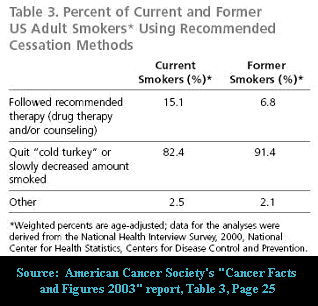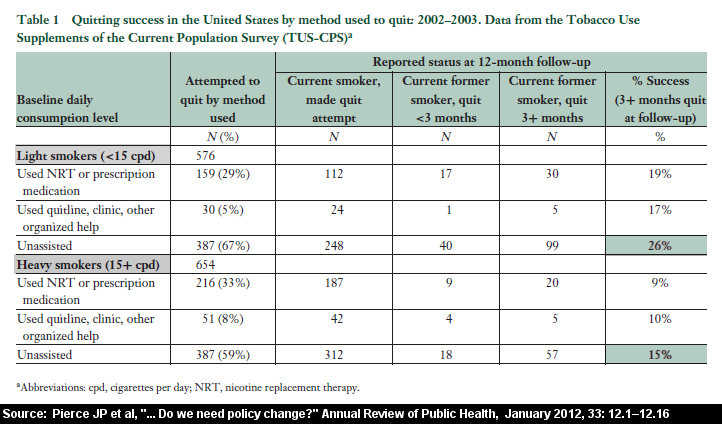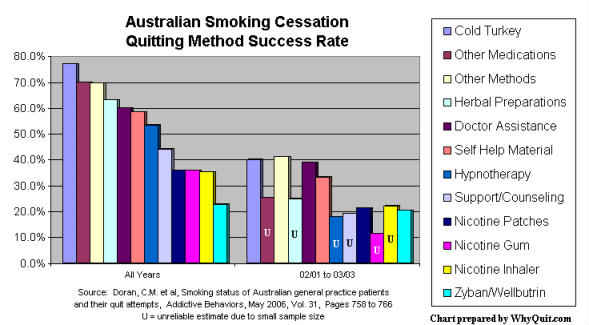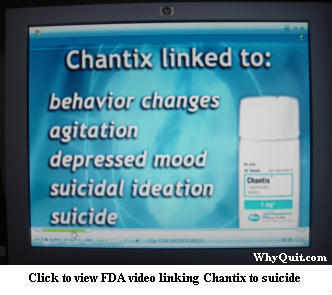
Are cessation pharmacology quit smoking products such as NRT, Chantix and Zyban a sham upon smokers?
What All Successful Quitters Have in Common
Tomorrow there will be hundreds of millions of comfortably recovered nicotine addicts alive on planet earth and they'll all have one thing in common. They didn't put any nicotine into their bodies today. A 1990 study found that 93.5% who lapsed and "tasted" one cigarette during the first three months of quitting went on to experience full relapse to smoking. It's called the "Law of Addiction."
Many master the "Law of Addiction" through repeated relapse and the school of hard-quitting-knocks. Only a tiny fraction -- probably less than 1 percent -- learn the "Law" at education-oriented forums such as this. Frankly, most quit in ignorance of nicotine's ability to foster relapse. Sadly, that ignorance carries the potential to someday combine with crisis and again deprive them of freedom.
A basic understanding that just one puff or hit will cause up to 50% of our brain's a4b2-type dopamine pathway receptors to become occupied by nicotine can be highly protective. While most walk away from trying to cheat when quitting feeling like they've gotten away with it, we cannot cheat the design of brain circuitry whose job it is to make activating events nearly impossible, in the short term (the time needed for recovery), to forget or ignore. Our dopamine pathways would again reassign nicotine use the same priority as they assign to eating food. And it wouldn't be long before we found our brain wanting, conspiring to obtain, or even begging for more.
Open Lies and Hidden Truths
We nicotine addicts have been lied to by so many for so long that it's getting hard to believe anyone. The most disturbing lies are told by those seeking to profit by getting us to fear our natural quitting instincts. They feed upon the smoker's worry that stopping won't be as easy as they'd hoped. They tell them that few succeed by going cold turkey, that you'd have to be a superhero to do so.
 To the contrary, even today with smokers being drowned in a sea of quick-fix cures which include alternative nicotine delivery devices, designer drugs that mimic nicotine, magic herbs, hypnosis, Smoke-Away, acupuncture, lasers, and every gimmick and ploy imaginable, a July 2013 Gallup Poll found that more ex-smokers quit cold turkey than by all other methods combined, that only a tiny fraction of all successful ex-smokers had used approved quitting products (just 8 percent).
To the contrary, even today with smokers being drowned in a sea of quick-fix cures which include alternative nicotine delivery devices, designer drugs that mimic nicotine, magic herbs, hypnosis, Smoke-Away, acupuncture, lasers, and every gimmick and ploy imaginable, a July 2013 Gallup Poll found that more ex-smokers quit cold turkey than by all other methods combined, that only a tiny fraction of all successful ex-smokers had used approved quitting products (just 8 percent).
That finding is consistent with a 2006 Australian study which followed the smoking patients of 1,000 family practice physicians and found that 88% of all successful quitters quit smoking cold turkey, and that cold turkey quitters were twice as likely to succeed as those using the nicotine patch, nicotine gum, nicotine inhaler or Zyban (bupropion).
Sadly, organizations such as the American Cancer Society have historically demonstrated a lack of quitting method recommendation integrity in accepting millions in contributions from companies granted the right to display the Cancer Society's trusted logo on their quitting products.
Smokers Make Easy Prey
While normal to dream of a cure for nicotine dependency, we must not close our eyes and minds to actual quitting results in an arena where the most ridiculous or even fraudulent quitting scheme imaginable should statistically generate quitting testimonials from 10-11% of users at six months (the "on-your-own" quitter's own natural quitting odds). It makes nicotine addicts naturally ripe for fraud. It's also costing millions their lives. And instead of the government battling against quitting fraud, most become active participants in fostering it.
Let's pretend that we concoct a new magic quit smoking product called Billy Bob's Lima Bean Butter. What's amazing is that the 10-11% who use our product, who would have succeeded anyway (unless it somehow undercuts their own natural odds of success as does NRT), will each deeply believe that our butter was almost entirely responsible for their success. No one will be able to convince them otherwise.
And we could double our butter's 10-11% six-month success rate by testing it on quitters quitting while using tools known to have their own proven effectiveness, tools such as ongoing group or telephone support, cessation education programs, coping skills development, quality self-help materials (which are rather rare), cognitive behavioral therapy, and group or individual counseling. It's a way to steal instant credibility and it occurred in almost all early NRT, Zyban and Chantix clinical studies. Pfizer's five original varenicline studies (Chantix and Champix) broke records for the number of counseling sessions, with up to twenty-five. Yet marketing awards all credit to varenicline.

How long should it have taken for allegations of fraud to start flying once it was realized that over-the-counter nicotine replacement products were only generating a 7 percent six-month quitting rate, that 93% buying and trying the nicotine gum or patch were relapsing?
As I asked in a letter published in the British Medical Journal in November 2013, "Despite 39 years and billions spent on marketing, only one in 100 US ex-smokers credit nicotine gum for their success, with all approved products combined accounting for only 8% of successful cessation. How much closer to consumer fraud can approved products get?"
As suggested by the below study reviews, it should bother all of us that during the past decade we have not seen a single independent, long-term (6 months or greater) real-world, population-level quitting method survey in which those purchasing and using replacement nicotine did as well as those quitting without it. Such smoker quitting surveys are inexpensive, quick, easy to generate, and successful quitters have absolutely no reason to lie about how they finally achieved success.

But those with a financial stake in replacement nicotine quickly dismiss quitting method performance surveys as "unscientific." What should be dismissed as unscientific is the randomization of smokers self-seeking replacement nicotine (not cold turkey quitters), to either nicotine or placebo devices, in clinical NRT studies that the pharmaceutical industry knew back in 1982 were not blind, as has been falsely claimed ever since.
Frustrated Expectations Key to Billions in NRT Profits
When it comes to trying to blind study participants as to their randomized assignment to either a replacement nicotine product or a placebo look-a-like, intellectually dishonest NRT researchers have pretended that nicotine is not a psychoactive chemical whose presence or absence is easily recognized by participants with significant quitting histories. The more quitting attempts a smoker has made, the more expert they became at recognizing withdrawal's onset.
Within seconds of use, nicotine generates a recognizable wanting satisfaction "aaah" sensation. Not only does it cause the brain's dopamine pathways to satisfy wanting, it activates the body's fight or flight response which perks the senses, accelerates heart rate by up to 20 beats per minute, shuts down digestion, pumps stored fats and sugars into the bloodstream thus avoiding hunger pains, and constricts peripheral blood flow which actually drops the temperature of fingers and toes by up to 5 degrees.
Pretend for a moment that you heard about a nicotine gum study at the local hospital offering participants three full months of free nicotine gum. There was only one catch. Half of those signing up would be randomly assigned to receive placebo gum instead, which contained no nicotine. Would you be able to tell if the nicotine gum you were assigned to chew was a nicotine-free placebo instead of the real thing? So could far too many of them.
If you had joined hoping to receive three months of free nicotine gum, would you have stuck around once you felt the onset of full-blown nicotine withdrawal and realized that your expectations had been frustrated? It's why replacement nicotine, Zyban and Chantix clinical trial odds ratio victories over placebo reflect expectations, not product worth.
As shown by the June 2004 Blind Spot study, anyone asserting that NRT studies were blind or that their results are "science-based" has their head in the sand. How bad is it? An April 2005 study assessing blindness found that three times as many assigned to the placebo group correctly guessed that they had been using the placebo as guessed nicotine. That finding was echoed in a 2009 nicotine patch study by the co-inventor of the nicotine patch.
In November 2008, Canada's largest medical journal published my assertion that it is wrong to pretend that "researchers were somehow able to hide the onset of nicotine withdrawal symptoms from control group members, whose previous quitting history had taught them exactly how withdrawal felt (a rising tide of anxieties, anger, dysphoria, concentration difficulty and sleep fragmentation within 24 hours of quitting), and that researchers found a way to mask the reduction of withdrawal syndrome for intervention group members." I asserted that, "pharmacologic treatment of chemical dependency may be the only known research area in which blinding is impossible."
It's why such studies are worthless and reflect junk science at its worst. It's why the researcher who understands the placebo study scam/sham, and uses it to help the pharmaceutical industry make millions, is a criminal who belongs behind bars. They are delaying cessation and costing lives. I submit that their day is coming, that science and history will someday declare that bogus replacement nicotine study findings indirectly killed millions.

The only published defense against my blinding impossibility assertion has been that "incomplete blinding is a potential limitation to most clinical trials." I replied reminding researchers that "most clinical trials do not involve an attempt to improve a syndrome (chemical withdrawal) that was non-existent when the trial commenced," that "cessation pharmacology's unique objective isn't treatment of some ongoing pre-existing condition but reduction or elimination of insula driven withdrawal anxieties that arise after randomization, after the trial commands participants to commence cessation," and that "this raises unique, profound and obvious blinding concerns which demand unbiased scrutiny due to extremely dismal real-world pharmacology performance."
I've also taken the opportunity to remind researchers that the World Medical Association (WMA) Declaration of Helsinki commands that the "benefits, risks, burdens and effectiveness of a new intervention must be tested against those of the best current proven intervention" and that placebos should not be used unless "compelling and scientifically sound methodological reasons" are demonstrated. I noted that placebo is not a real-world quitting method, the expectations of those joining pharmacology trials are not shared by cold turkey quitters who fully expect to endure withdrawal, and that it is time to either adhere to WMA placebo use standards or accept full responsibility for the premature demise of quitting study participants whose human rights were violated.
Think about the benefits of approved quitting products never having to compete against the "best current proven intervention" or against real cold-turkey quitters who were educated and supported. It enables their charade to continue.
Contrary to stakeholder assertions, those wanting to quit smoking cold turkey were never invited to complete against self-selecting smokers seeking months of free replacement nicotine. I submit that if honest competition had occurred there would have been no need for these words or this page.
Industry Cover-up Hides Findings That Would Diminish Sales
Clinical cessation studies likely reflect the worst junk science ever perpetrated upon humans. Shamefully, true science has turned its collective head as those with a stake in nicotine sales were allowed to redefine "quitting" so as to label a natural insecticide "medicine," to term its use "therapy," and, in declaring success, compare those who had quit using it to those who had not.
But who has greater culpability, those who have knowingly engaged in dopamine pathway stimulation junk science, or government agencies and health organizations which continue to hide critical findings that would allow smokers to make informed, intelligent and reasoned decisions?
What percentage of over-the-counter NRT users are still not smoking at six months? Wouldn't this be an important fact to know if planning to quit? I challenge you to locate an answer at any government, health or commercial website advocating NRT use. A March 2003 study, conducted by NRT industry consultants, combined and average all seven over-the-counter NRT patch and gum studies and found that only 7% of study participants were still not smoking at six months. It's actually worse than 7%. The same industry consultants published a November 2003 study that found that as many as 7% of successful gum quitters and 2% of patch users were still hooked on the gum or patch at six months. Obviously, these were two entirely different studies but even so the math for nicotine gum (7-7=0) screams deceit.
Seventy percent of surveyed U.S. smokers say they want to quit and the vast majority have now attempted quitting with pharmacology and failed. Millions have now failed at multiple NRT attempts. How many priceless periods of quitting confidence does the average smoker have in them before joining the 50% of all adult smokers losing an average of 13-14 years of life? What is a quitter's odds of success during a second or subsequent NRT attempt? Is it important information? As with the 7% OTC NRT six month rate, try to locate any government or health organization quit smoking website that tells quitters their odds during a second nicotine patch attempt. I've been unable to locate any.
The pharmaceutical industry, government health agencies and health non-profits have known since as early as 1993 that if you have already tried quitting once with the nicotine patch that your odds during a second attempt drop to near 0%. Yes, unlike cold turkey, where the odds of discovering the power of one puff (or hit) of nicotine to foster full relapse actually increase with each failed attempt, the repeat NRT quitter's odds of success dramatically decline with subsequent use.
What lesson is eventually learned by repeat use of the very chemical we're dependent upon? Look closely at quitting attempt representations at sites advocating NRT use. If NRT success rates actually do decline with repeat NRT use, shouldn't use of what are primarily cold turkey quitting attempt statistics, in order to create false expectations for repeat NRT use, be considered criminal? Toying with the very chemical we were dependent upon has interfered with natural self-discovery of the Law of Addiction through the school of hard-quitting-knocks and substantially contributed to stalling the decline in the U.S. smoking rate.
We now know that at least 36.6% of all current nicotine gum users are chronic long-term users of greater than 6 months ( Tobacco Control, Nov. 2003). Unlike the gum, which traps some nicotine, the nicotine lozenge fully dissolves, delivering up to 25% more nicotine. We have absolutely no reason to believe that the number of quitters getting hooked on the cure isn't at this moment climbing higher. Researchers continue to ignore long-term NRT-addict concerns about increases in tolerance and losing their hair and teeth.
If you are able to get your brain's dopamine, adrenaline and serotonin pathways adjusted to again functioning without nicotine at the exact same time that you are feeding them nicotine, you should be extremely proud of yourself because you are in fact a superhero. But if you are among the 93 out of 100 first time OTC NRT users who quickly relapse, or among the nearly 100% who fail during a second or subsequent attempt, do not grow discouraged as you are in some wonderful, wonderful company.
Chantix and Champix (varenicline) Killing Quitters
I've entitled my primary Chantix/Champix article, "Will Chantix really help me quit smoking?" and assert that the odds are "not  good," probably in the neighborhood of 1 in 11 of being able to quit for one year if used as a stand-alone quitting product without any accompanying education, counseling or support. There's simply no nice way to say it. As shown at the below links, smokers using a chemical in order to try and save and extend their life are instead being killed by it. It makes no sense.
good," probably in the neighborhood of 1 in 11 of being able to quit for one year if used as a stand-alone quitting product without any accompanying education, counseling or support. There's simply no nice way to say it. As shown at the below links, smokers using a chemical in order to try and save and extend their life are instead being killed by it. It makes no sense.
Worse yet, when examining both 6 month and 1 year "7-day point prevalence abstinence rates (determined by asking participants whether or not they had smoked a cigarette within the prior 7 days), in the only head-to-head competition between Chantix and NRT, a 2008 nicotine patch study, Pfizer's researchers were forced to report that there "were no significant differences" between Chantix and nicotine patch users at either 6 months (varenicline 38.6% vs. patch 34.1%) or one year (varenicline 34.8% vs. patch 31.4%).
Nicotine addicts are not breaking free because of weeks or months spent toying with chemicals that stimulate brain dopamine pathways but in spite of having done so. Our core dreams and desires for freedom are not altered by standing in front of any weaning product or even Billy Bob's Lima Bean Butter. It is "you" who'll do the work. As long as you remain obedient to the Law of Addiction, locate a source of ongoing support and keep your day #1 dreams vibrant and alive long enough to allow you to again become entirely comfortable within nicotine-free skin, you'll eventually be free to award full credit to any product or procedure you desire. But the truth is, the glory will be 100% yours!
It should be noted that many of the below NRT studies focus almost exclusively on over-the-counter (OTC) replacement nicotine products used as stand-alone recovery tools. Obviously, the 7% OTC NRT six-month rate should increase when used in conjunction with any program having a support, education or counseling component, depending upon the intensity and quality of the program. But with an almost complete absence of NRT compliance programs in U.S. cities, and less than 1% of all quitters turning to the Internet for cessation assistance, the below studies accurately reflect how almost all replacement nicotine products are today being used.
Keep in mind that a 7 mg. nicotine patch delivers the nicotine equivalent of smoking seven cigarettes a day. In the end, all drug addicts who successfully recover must give-up their drug. In fact, all successful quitters eventually go cold turkey. At that moment the rule becomes the same for all ... no nicotine just one day at a time ... Never Take Another Puff, Dip, Suck, Chew or Patch!
Studies and Insights that NRT, Chantix & Zyban Profiteers Will Never Share
2018 - Cold turkey clobbers e-cigs, NRT and Chantix
2017 - JNCI study finds pharmaceutical stop smoking aids ineffective
2015 - Nicotine cessation: lost in the deserts of Abu Dhabi
2015 - 10 studies screaming "leave replacement nicotine alone!"
2014 - NRT bought OTC associated with 0.68 odds of abstinence
2014 - The Surgeon General's Reports: 50 years of cessation ignorance
2013 - British Medical Journal policy should extend to Pharma's nicotine
2013 - Gallup Poll: cold turkey 48 times smarter than Nicorette
2012 - Pharma bias destroys ITC quit smoking medication study
2012 - Potent warnings, horrible quitting advice: what's the CDC smoking?
2012 - Replacement Nicotine's Killing Fields
2011 - Chantix study joins negative findings omissions club
2011 - Dying Truths About Quitting Smoking Methods
2011 - Is a 14% Chantix success rate worth risking death?
2011- Chantix serious injuries exceed 8,500
2011 - "Smoke Remedy" infomercial: a fraud, hoax and scam?
2010 - GlaxoSmithKline Continues Defrauding Smokers
2010 - Smokefree.gov really Buymeds.now
2009 - Five Facts Chantix Ads Keep Hidden
2008 - Long-Term Nicorette Gum Users Losing Hair and Teeth
2008 - Have Smokers Been Hoodwinked and Bamboozled by Placebos?
2008 - Pfizer's Chantix Continues Killing Quitters
2008 - Chantix and Champix mental health safety assurances contrary to evidence
2008 - Chantix and Champix linked to depression, aggression and suicide
2008 - Chantix blamed for 3,063 serious injuries and 78 deaths
2008 - U.S. quit smoking policy integrity drowns in pharmaceutical influence
2008 - Does updated tobacco treatment "Guideline" reflect sham science?
2008 - World Tobacco Conference Accused of Prostitution
2008 - FDA Chantix Handling Betrayed Public Health
2008 - Nicotine Damages First Trimester Embryo
2007 - "What if my Chantix or Champix attempt failed?"
2007 - Flawed research equates placebo to cold turkey
2007 - Nicotine Fix--Evidence of Collusion: Pharma-Govt Smoking Guidelines
2007 - Wall Street Journal Article Highlights Financial Conflicts of Interest of Chair of Federal Smoking Cessation Guidelines Panel
2007 - NICOTINE FIX: Behind Antismoking Policy, Influence of Drug Industry
2007 - Nixing the patch: Smokers quit cold turkey
2007- Critical Review: Nicotine for the Fetus, the Infant and the Adolescent?
2006 - 90% of Ex-smokers Quit Smoking Cold Turkey
2006 - Is the U.S. Government's Quitting Policy Killing Smokers?
2006 - Champix - an 8 in 10 failure rate or worse?
2006 - "Will Chantix really help me quit smoking?"
2006 - Cold Turkey Twice as Effective as NRT or Zyban
2006 - Nicotine Not Medicine, Its Use Not Therapy
2006 - Nicotine 166 Times More Deadly than Caffeine?
2005 - GlaxoSmithKline Attacks Cold Turkey Quitting
2005 - The Patch, Gum and Lozenge: growing evidence of a sham upon smokers
2004 - Widespread blinding failures put validity of NRT studies in serious question
2004 - Canadian quitters disprove "double your chances" NRT industry assertion
2003 - Do 7% of nicotine gum quitters become hooked on it? Is 36.6% of all gum purchased by chronic gum users?
2003 - Are nicotine weaning products a bad joke?
2003 - Is cold turkey quitting both more productive and effective than NRT?
2003 - Are teen never-smokers getting hooked on NRT?
2003 - Study combines all OTC patch and gum studies and finds that 93% relapse to smoking within six months
2002 - Journal of American Medical Association study declares "NRT appears no
longer effective in increasing long-term successful cessation in California smokers"
2002 - New "real-world" study shows that on average only 7% of OTC and Rx NRT quitters quit smoking
2002 - U.S. Guideline evidence tables suggest historical and natural "on-your-own" six-month quitting odds of 11.5%
2000 - Is NRT the smoker's last best hope?
2000 - Study finds nicotine patch "does not appear to be effective for treatment of adolescent smokers"
1993 - Study find that 100% of second-time nicotine patch users relapse to smoking within 6 months
1986 - "Prolonging Withdrawal Syndromes"
1984 - "Quit Cold Turkey!"
Knowledge is a Quitting Method

